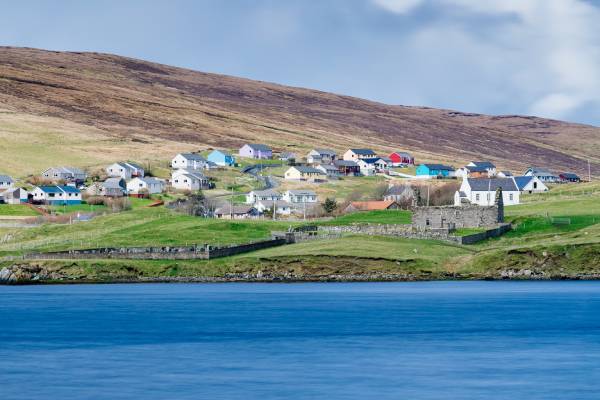As the Distribution Network Operator for the north of Scotland, we own and operate the 33 kilovolt (kV) and 11kV networks on Shetland, which are made up of approximately 1,650 km of overhead lines and underground cables operating at distribution voltages (33kV and below).
During the introduction of the British Electricity Trading and Transmission Arrangements (BETTA) of 2005, it was formally agreed that we would also administer electricity generation as well as network operation on Shetland, although we had been fulfilling this role for some time before this.
This means that, as we are responsible for balancing the islands’ supply and demand, we are also the System Operator (SO) on Shetland.

Existing arrangements
Most of Shetland’s electricity is currently supplied by two fossil-fuel power stations, with the remainder being supplied by renewable generators.
Shetland’s main electricity generation sources are:
Lerwick Power Station (LPS)
A 72.8MW diesel-fired station that provides around 50% of Shetland’s electricity on an annual basis. We’ve recently installed a new engine and 8MW battery to supplement the existing station, and to further increase the amount of renewable generation which can be accommodated on the network.
The station was built in 1953 and is approaching the end of its scheduled full-duty operational life, however the station is still very much a part of our future plans, which you can read about here and also further down the page in the “Standby Proposals” section.
Sullom Voe Terminal (SVT) Power Station
An independently owned gas-fired power station, which meets around 30% of Shetland’s demand. The station’s primary purpose is to supply electricity to the Sullom Voe gas terminal, but it also provides power to the Shetland system through a contractual arrangement.
Renewables
A number of small independent and community-based renewable generators, including wind and tidal, which currently contribute around 20% of the islands’ electricity supply.
Most of these generators are managed by the Shetland Active Network Management (ANM) system, which originated in an innovative trial project developed by SSEN in partnership with third parties called the Northern Isles New Energy Solution (NINES).
The ANM aims to increase renewable generation output and reduce reliance on fossil fuels on the island network, taking advantage of the above-average wind conditions that Shetland experiences.
Looking to the future
Gremista Grid Supply Point
Electricity is currently distributed on Shetland via our 33kV distribution network.
Once the Shetland Islands are connected to mainland GB via the new High Voltage Direct Current (HVDC) subsea cable and the new onshore 132kV network currently under construction by SSEN Transmission, the distribution and transmission networks will need to be connected at a new substation – this is what is known as a Grid Supply Point (GSP).
We are working jointly with SSEN Transmission to develop and construct the new GSP on land close to the existing Lerwick Power Station (LPS).

Construction works
SSEN Distribution has appointed island-based Tulloch Developments as its principal contractor for these works, which started on site started in November 2022.
Working through the challenges of a typical Shetland winter, teams continue to progress well and the Distribution element of the project is on schedule to be handed over to SSEN Transmission in the summer of 2023.
After the site is handed over to SSEN Transmission, their teams will complete the civil and electrical works required to connect the GSP to the transmission and distribution networks.
Keeping the power flowing - standby proposals
While the transmission system will supply Shetland’s demand needs for the vast majority of the time, a standby solution is also required to ensure homes and businesses continue to receive the power they need during transmission system outages.
We have been reviewing options for a reliable, innovative and cost-effective backup solution to support the security of supply to Shetland once the islands are connected to the mainland GB electricity system via SSEN Transmission’s 600MW HVDC transmission link.
Our standby solution is scheduled to be available at the same time as our connection to the Transmission network at the GSP in Gremista, and Shetland is then connected to the GB mainland electrically. These are aligned to ensure the standby solution is available for any planned or unplanned outages on the Transmission network or HVDC link.
More information
For more details on our standby proposals, please see page 92 of our RIIO-ED2 Business Plan

